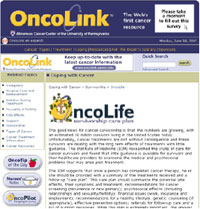 |

Decision Aids Give Patients More Say in their Cancer Care
 Recently, interactive programs have become available in print and online to help patients take a more active role in their health care, from choosing a treatment plan with their physician, to identifying late effects and follow-up care after treatment ends.
Recently, interactive programs have become available in print and online to help patients take a more active role in their health care, from choosing a treatment plan with their physician, to identifying late effects and follow-up care after treatment ends.
Tools such as these are an attempt to address shortfalls of the U.S. health care system, many of which were outlined in a recent Institute of Medicine report. By enabling patients to communicate effectively with their providers about the benefits and risks of cancer treatment, as well as the possible consequences that should be monitored, these tools could be a helpful cancer care supplement.
One such tool published online this past July, called OncoLife, was developed by a team of oncology nurses and physicians from OncoLink.org, the Web-based cancer resource of the Abramson Cancer Center of the University of Pennsylvania. Using a computer, patients or clinicians can check boxes and select options from drop-down menus according to type of cancer and treatments received. The program generates a summary of the possible treatment side effects - secondary cancers, bone-density loss, infertility, and cognitive problems, for example - which is called a Survivorship Care Plan.
"My oncology nurse actually fills these out for each one of my patients and we hand it to them as they enter the cancer treatment process," says Dr. James Metz, editor-in-chief of OncoLink and assistant professor and chief of clinical operations in the Department of Radiation Oncology at the University of Pennsylvania.
OncoLife tracks information about its users so that the system can evolve according to their needs, as well as with the latest updates to treatment information, explains Dr. Metz, who notes that the first update to OncoLife is expected in the next few months.
"We are seeing a 'perfect storm' in health care that is going to drive increased demand for these technologies," says Dr. Brad Hesse, chief of NCI's Health Communications and Informatics Research Branch. The advent of widespread electronic health records and a predicted surge toward direct-to-consumer marketing of health care are all moving Americans toward a do-it-yourself attitude, he explains.
Research also supports the concept of patients becoming more actively involved in decisions about their cancer care. Several studies with breast cancer patients, for example, have shown that when a woman was involved in the decisions surrounding her treatment plan, she was more likely to be satisfied with the result and with her life than if she had not been involved in the decision. This was regardless of the treatment she received or her outcome in the years that followed.
There are some concerns, though, with a possible lack of human interaction when patients begin to rely upon decision tools. The most recent data from NCI's Health Information National Trends Survey (HINTS) show an increasing preference for health information that comes directly from a person, rather than from an inanimate source such as online or on paper.
"We are living in a new world where patients and survivors are expected to take greater responsibility for their health, and we're not all comfortable with that," says Dr. Julia Rowland of NCI's Office of Cancer Survivorship. "Some older cancer survivors, and those from different cultural backgrounds, for example, are more comfortable with a more paternalistic model of care; they expect their doctors to be the key decision makers when it comes to choices in their cancer care," she explains.
Low literacy and low numeracy - that is, what numbers associated with risk, such as percentages and "chances," really mean - are other factors that could render otherwise helpful information useless, or possibly alarming, in unattended hands. For this reason, the IOM report recommends that health care professionals review survivorship care plans with patients during a formal discharge consultation.
Dr. Wendy Nelson, a program director in NCI's Basic and Biobehavioral Research Program, notes that NCI is funding several projects to examine how technology can help patients access and understand health information. "Decision aids are not a panacea," she says. "They have the potential to be useful adjuncts for patient-physician decision making. However, we still have a lot to learn about how decision aids work and how they are being used, even as we develop them."
— Brittany Moya del Pino
|